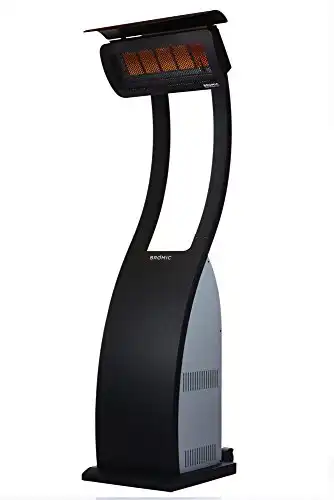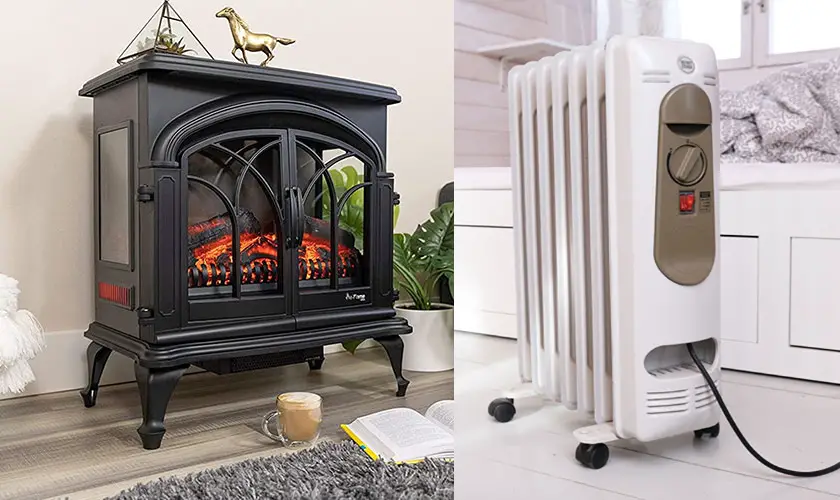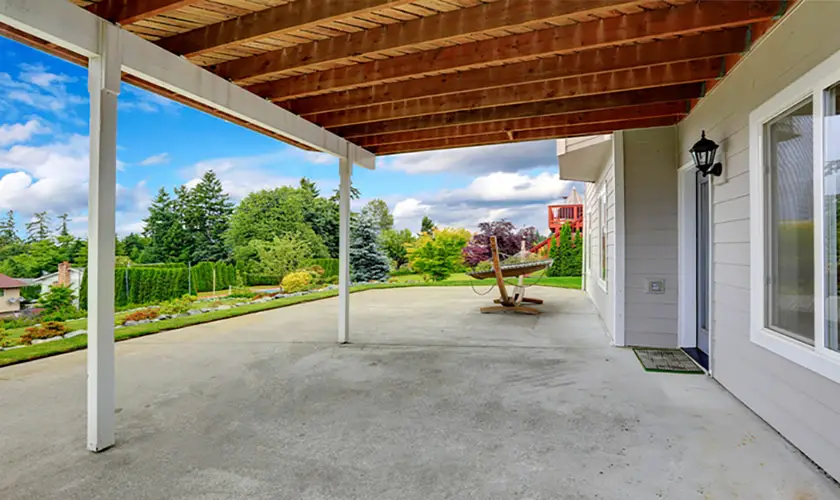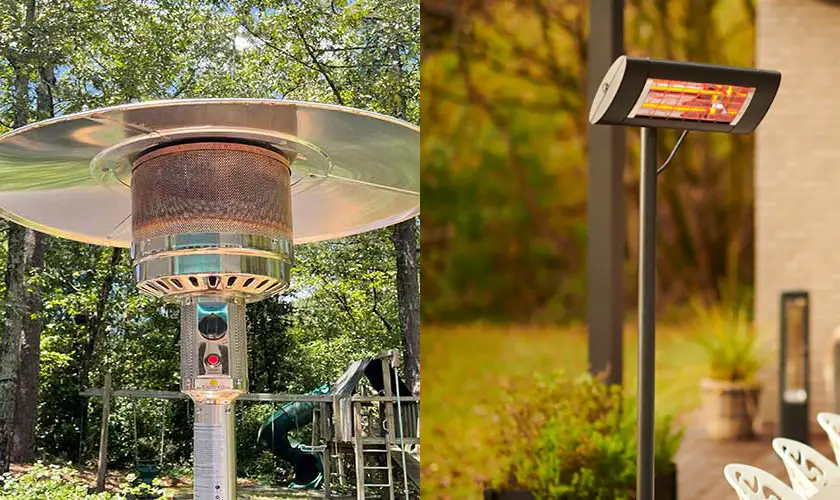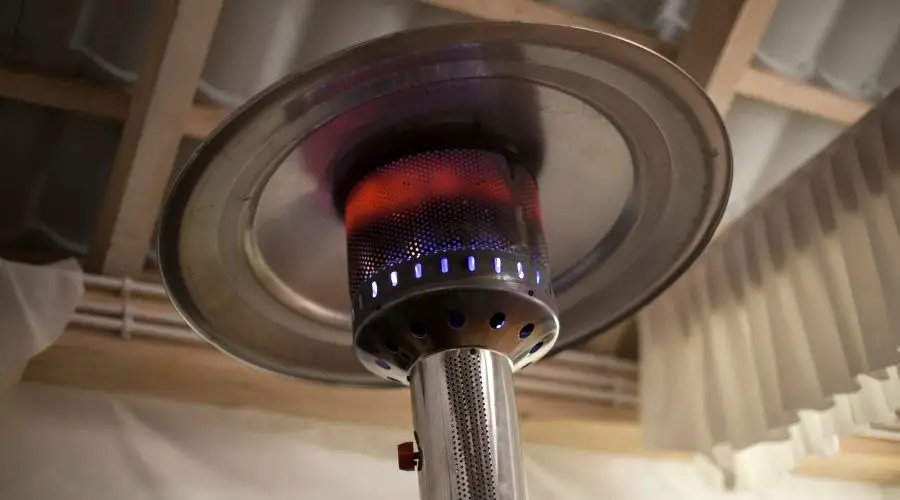
Many people still like to spend quality time outdoors on those cooler days and nights. A patio heater is considered a way people can still enjoy their garden when it is a bit chilly, making it warm enough to sit outside. But do they work, should you buy one, and if so, which one? This article will cover all you need to know about patio heaters.
Patio heaters are very much worth it. They come in different shapes and sizes and can satisfy various needs. Although the initial cost can be heavy, it usually pays off in the long run.
Patio heaters are an option for those who love to spend time outdoors in the winter. In the last ten years, demand for outdoor patio heating has exploded, and industry experts expect nothing but a rise in patio heaters’ popularity. But to determine if buying a patio heater is worth it, we need to analyze how they work and explore further.
What are Patio Heaters & How do they Work?
Patio heaters are heating appliances that generate thermal radiation. They convert electricity into infrared heat transmitted by electromagnetic waves through the air until they reach an object meaning that the patios heaters do not warm up the air around us but heat us.
A patio heater is a freestanding heating system that uses radiant heat to heat the surrounding area. Radiant heat travels through the air and warms nearby people and objects.
It means that the closer you sit to it, the warmer you’ll get. The area patio heaters warm-up will depend on the patio heater’s scale.
There are a few types of heaters we will be diving into today:
1. Electric Patio Heaters
A common type we see is an electric heater. It is popular because it is simple to use, very compact, and safe to use in enclosed spaces.
However, electric patio heaters can cost more in the long run due to electricity costs, and you must place them near an outlet. It also takes longer to heat up than other models, but that depends somewhat on the actual heater.
2. Propane Patio Heaters
But patio heaters can also burn gases, such as propane. They do not blow warm air; instead, the electromagnetic waves travel until they reach a person or object. Patio heaters that work on propane have a low cost, but you’ll need to replace the tanks periodically.
As soon as the heater turns on, it starts to run. The valve opens, where the burners are mounted, and the propane or gas travels to the tip. The burners heat the radiant portion at the top, and the heat spreads to warm the room around the heater.
3. Freestanding Patio Heaters
Freestanding heaters are one of the most popular designs. They do not require permanent installation on the wall, and you can move them from one spot on the patio to the other. These heaters use portable propane tanks that burn and turn into heat.
4. Natural Gas Patio Heaters
Heaters that burn natural gas are safer than heaters that burn wood. Also, they burn cleaner than wood. However, since they connect to a natural gas pipe, they should be mounted professionally and are thus more costly upfront in general.
They are often less compact than other versions because they need to be connected, but portable tanks solve this problem.
5. Wood-burning Patio Heaters
One of the most affordable solutions is wood-burning patio heaters. The downside is more intensive maintenance since frequent cleaning of ash and coals should be practiced. They are also harder to light and cause sparks and embers, unsafe if left unattended.
How Much Energy do Patio Heaters Use?
To sum it up, the most common patio heaters are the ones that run on electricity or gases. Heaters that run on electricity are cheaper and more environmentally friendly. They are also quieter and consume less energy.
For industrial consumers who need to heat a wide area, gas heaters have a more negligible upfront expense, but there is a reduction in cost savings when considering the cost of gas.
You can buy a 15000W (watt) gas patio heater with a 52,000 BTU capacity for around $400, plus an additional $80 for a gas tank.
So, the upfront cost of a gas heater is significantly lower. The gas patio heater can use around 2 pounds of gas per hour. This cuts into your initial investments easily.
A full-power 2kW electric heater would cost about $.40 an hour, while a gas patio heater of 15kW costs about $4 an hour. The price of an electric heater per hour depends on the average cost of kWh.
Many home users would not need 52,000 BTUs to heat their patio. Home consumers can save even more on budget patio heaters—a 30-pound propane gas tank costs around $40.
Approximately 8 ounces of gas per hour is used for most typical patio heaters at maximum load (3000W). We would expect this patio heater to cost us around $0.85 per hour at full strength.
For 5000 hours, the electrical heater would cost you $1,345 less than the gas patio heater. The electric heater is roughly 2/3rds of the gas patio heater price.
Are Patio Heaters Efficient?
It is more practical to use propane-fueled heaters because they produce the highest heat strength. Since they are not reliant on wires and an electric socket, these heaters are more convenient.
These heaters are often developed not to trigger fires, and protection features are built into the device to protect users against injuries.
Electric Patio Heaters
It may seem better to use electric heaters in the same price range as propane heaters. However, for the same quantity, less heat is produced. It is easy to put electric heaters on tables or install them on walls, but they only have heat after a few minutes of use.
The most significant upside of electric heaters is that they use 85% less energy. They are the best way to preserve energy and bills while no one is out on the patio.
Furthermore, electric heaters are much more powerful, which means they will concentrate the outgoing warmth on a mark, ensuring that instead of the air, the people around it can get warmer.
Propane Patio Heaters
As soon as a propane heater turns on, it generates gas. Because of the energy source, electric heaters do not cause the same amount of heat as propane heaters.
Propane patio heaters are low-cost and energy-efficient heaters that offer a great deal of warmth and usage to a patio or outdoor venue. They produce 30,000 to 40,000 BTUs., depending on the heater’s strength.
Of course, there are other ways of keeping warm outside in the winter. It would be best to build the right environment to feel warmer and reduce draughts that instantly strip the generous layer of air.
Lighting will help, as daylight affects our understanding of how cold we are. Warming up cold feet with under-table heaters or even foot warmers on a cold day is also a great option.
Do Patio Heaters Work in the Winter?
Patio heaters can produce warmth in winter by emitting radiant heat, even if the air is freezing and the wind is blowing.
They’re not going to shield you from the wind or provide any protection against the rain, but they’re going to give some warmth at low temperatures.
While heaters with more power are more costly to operate, they can provide a more extensive range and temperature.
Investing in an effective heater that might initially be more costly but can save you in the long run could be the way forward.
All-electric patio heaters and gas heaters emit radiant heat. This kind of heat will flow through the air. It moves through the air, keeping everyone around the patio warm, unlike regular heat, which stagnates in the air.
How they heat the air is something that differentiates these heating systems. On the one hand, the radiant heat can be sensed only by objects and individuals in line. On the other hand, space heaters move some of their energy to the air, allowing others to feel the heat.
How do I Keep My Patio Warm in the Winter?
There are several options to help make your heaters more potent if you have an oversized outdoor patio that needs heating, or if you are trying to heat a wide-open area, it is a bright idea to reduce the wind. Using windbreaks can help insulate the room and create a sun trap.
- Cover your patio: The wind has the most significant effect on heat and will take it in the opposite direction. Gazebos and covered patios are another great way to help insulate the heat and offer a more comfortable area for you and your visitors. Just make sure that the materials are fire-resistant.
- Choose the right location for your patio heater: When you think about where you want to place a heat source, think about where you spend the most time. It makes the most sense to heat this place, but to make it safe, you might need to rearrange it.
- It is crucial to place your heater a reasonable distance away from something flammable, particularly if it has an open flame. If the heater is powered by gas, you would also need to ensure that it is situated in an open space with sufficient airflow to stop carbon monoxide poisoning.
- No matter where you intend to install a heat source, review the owner’s manual and follow any instructions from the manufacturer.
- Many models have built-in anti-tilt systems, but you should always take precautions to protect and stabilize your heater.
Thanks to their height, standing patio heaters prefer to spread heat over a wider area, but their size can also make them heavy, which means they are more likely to tip over.
- Every heater is different. It is necessary to closely look at your heater’s details and follow all directions, from cleaning and repair to general safety tips and service instructions.
- Make sure to follow the instruction manual of the maker carefully. When not in operation, certain kinds of heaters may require you to turn off the gas, while others may have specific distance specifications or other configuration criteria.
- And again, remember that the patio heaters are for outdoor use only. If you are unsure how to use the heater, consult a professional to get as much information as possible.
Can You Use a Patio Heater Under a Covered Patio?
You can use it under a covered patio if you have the right kind of heater. The heater must suit the dimensions of the balcony. While they are more secure under a roof than fire pits, each type of heater requires a different amount of caution.
Mushroom Patio Heaters
Without question, compact mushroom head patio heaters are the most common form of patio heaters for covered spaces. They are very efficient in distributing heat. This heater can be portable and mounted. Infrared mushroom heaters work on electricity, so they need to be mounted.
They produce infrared heat and require at least 2 feet of space between them and the roof in a covered patio. Also, create a space between the heater and any flammable material of at least 6 feet.
A mushroom heater that turns on propane is usually portable. Whereas a portable mushroom heater requires at least a few feet of space between the roof of your patio and itself, propane heaters have open fires compared to infrared heaters.
Because your typical patio heater is about 7 feet tall, your patio roof must be at least 10 feet from the deck.
Mushroom patio heaters are also safe to use as long as you maintain a distance of 6 feet between the heater and items of wood, lattice, umbrellas, and other flammable materials.
The portability of these heaters makes it easier to switch them around. What makes them so popular is their excellent adaptability.
Electric Patio Heaters
An electric heater is another popular choice for a covered patio. Many electrical heaters spread heat horizontally, meaning that you can position the heater with just half a foot of clearance from the roof. Also, you never have to think about running out of propane with an electric heater.
To have a heater in a covered patio is great to protect it from rain. Although most outdoor heaters should survive the occasional drizzle, exposure to the elements can reduce their lifetime. Many patio heaters are very heavy, and shifting them around all the time isn’t always convenient.
Even though you can use mushroom heaters under the covered patio, they are built to operate better in the open, with no roof over them.
One thing you can do is tilt the heater slightly towards the patio’s open side. Tilting it would increase the dispersion of heat and make the environment warmer. When angling a patio heater, be conscious that it is steady and will not tip over.
Do Patio Heaters Give Off Carbon Monoxide?
As people become increasingly aware of environmental concerns, discussing the different heaters’ environmental impacts is worth discussing. Electrical or infrared heaters do not produce toxic gases; a gas heater emits carbon monoxide and nitrogen dioxide.
The gas heater uses oxygen to burn the gas and produce heat. The result of the burning gas is usually carbon monoxide and nitrogen dioxide.
Outdoors, those gases immediately disperse and flow away, but if used in a small closed room, it will quickly burn the oxygen and replace it with carbon monoxide.
According to some sources, four tons of carbon dioxide a year can generate by operating one patio heater most nights and some lunch hours, approximately equal to two-thirds of the entire household’s carbon dioxide production. Many people use their patio heaters less than that, but they have a noticeable impact on the atmosphere.
Natural gas and propane burn cleaner to feel more environmentally friendly, creating no smoke or odor. However, like any electric, propane, or natural gas system, propane heaters are not ecologically neutral; they absorb energy and potentially emit carbon dioxide.
If you’re worried about your patio heater’s environmental effect, limit your usage to when it’s most important, and follow all directions.
Gas heaters emit low levels of carbon monoxide when correctly operated and modified. Even when perfectly lit, all gas heaters will emit high amounts of carbon dioxide, raising the home levels.
Nitrogen dioxide is a toxic gas that causes irritations in the upper respiratory system, such as cough, headache, sore throat, and nausea. The nitrogen dioxide produces in a flame, but its amount depends on the size of the burner.
Flu symptoms, including headaches, dizziness, and nausea, are early symptoms of carbon monoxide poisoning. Because of this, it is essential not to bring the outside heaters into small rooms. However, you can find portable heaters designed for small spaces.
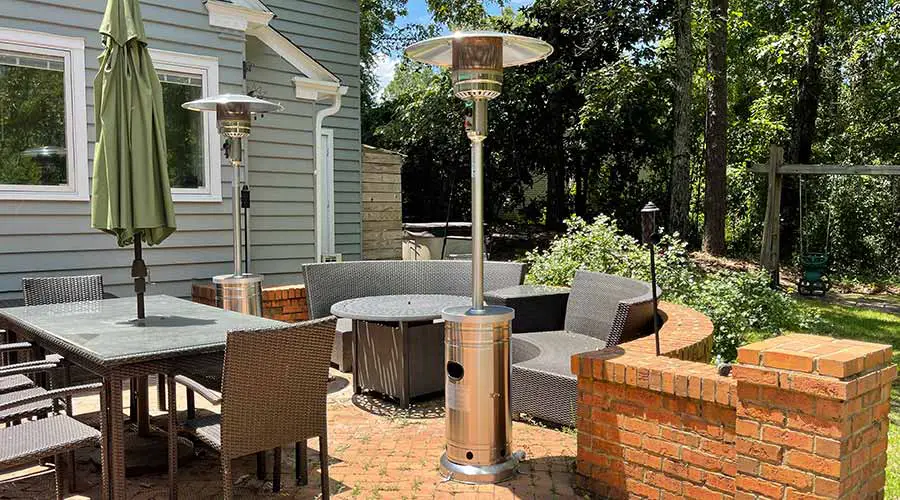
Best Patio Heaters
A bromic portable heater is one of the most modern heaters. It is not a typical mushroom heater; preferably, it has a head that heats in one direction. It uses infrared burners powered by gas to keep everyone warm.
It heats everything to 15 feet in front of it, or around 180 square feet. It has a stylish design, and due to its weight, it has wheels on the bottom, making it easier to transport. Since it uses infrared heaters, there is no fear of open fire.
That means you can appropriately place it without blowing heat at the edge of a table or patio umbrella in directions where no one is seated. You can adjust the heat from 21,500 up to 38,500 BTUs per hour.
It has a chic, modern design and comes in black to blend nicely with the surrounding. The large base makes it resistant to tipping as well.
You can easily remove the magnet cover to enter the propane tank section, containing either a 20-pound or 30-pound tank. On a high setting with a 20-pound tank, the heater can run for up to nine hours.
It will even run and keep working if a light wind is present. The recommended tank size and weight are 20 pounds, but its sturdy frame can easily hold the 30-pound model.
It is very weather-resistant, but we must note that it is not waterproof, as is the case with many outside heaters. It will endure a few drops of rain, but do not use it or leave it out in the rain.
You can shorten its lifetime significantly. You can use a heater cover to protect it from rain, dust, and different particles that can damage it.
The heater’s weight prevents it from tipping over, even when high winds are present. The materials are high-quality, and it is incredibly sturdy and firm. The heating’s size and power mean that you don’t have to sit directly under it.
Also, one of the advantages is that you can use it on covered patios. It requires minimal space under the roof since the heating head points downwards.
When you do buy it, though, you’ll need to assemble it. The manufacturers provide a manual to help you with this. You can also choose to install it professionally, and they can do it in less than an hour.
Dr. Infrared is perfect for covered patios, providing instant warmth. The heater offers three output heat settings: 900, 1200, and 1500 watts, plug into a standard 120V. It is designed to be mounted on the wall, and you can control it with a remote. When you order it, it comes with wall and ceiling mounting brackets.
It is an infrared heater for indoor and outdoor applications. It offers healthy, clean, instant, and odorless infrared heat, providing maximum comfort for indoor or outdoor winter activities.
If you do not want to mount it on the wall, you can buy a separate tripod to make it portable. But the tripod needs a very steady surface and is more prone to be tipped.
The heater is made of aluminum. Aluminum is one of the most durable materials you can get. Being made in this material means that the heater is resistant to corrosion and can sustain shallow temperatures.
It is also waterproof and weatherproof. But even though it is waterproof, do not use it in the rain, again, as it can lower its lifetime.
It warms up instantly and is ready to heat everyone in the area in minutes. While it is remote-controlled, it also has a built-in timer that you can automatically turn off the heater. This heater is great for cutting off the chill in the room and bringing it to a comfortable level.
The heater is safe to use around children, budget-friendly, and has a large coverage area. You can use it effortlessly in a room that is 1,000 square feet big.


